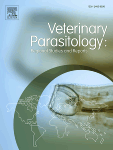Ver ítem
- xmlui.general.dspace_homeCentros Regionales y EEAsCentro Regional CórdobaEEA Marcos JuárezArtículos científicosxmlui.ArtifactBrowser.ItemViewer.trail
- Inicio
- Centros Regionales y EEAs
- Centro Regional Córdoba
- EEA Marcos Juárez
- Artículos científicos
- Ver ítem
Molecular characterization of Cryptosporidium spp. from domestic pigs in Argentina
Resumen
Cryptosporidiosis in pigs is caused by different Cryptosporidium species or genotypes, with C. suis and C. scrofarum considered porcine specific species. There is scarce information on Cryptosporidium infection in pigs in South America. A total of 520 individual faecal samples were obtained from 1, 2, 3 and 4 week old piglets (n = 130 from each age group), from 13 Argentinean intensive pig farms. The diagnosis of species of Cryptosporidium combined
[ver mas...]
Cryptosporidiosis in pigs is caused by different Cryptosporidium species or genotypes, with C. suis and C. scrofarum considered porcine specific species. There is scarce information on Cryptosporidium infection in pigs in South America. A total of 520 individual faecal samples were obtained from 1, 2, 3 and 4 week old piglets (n = 130 from each age group), from 13 Argentinean intensive pig farms. The diagnosis of species of Cryptosporidium combined microscopy and molecular techniques. Genotyping from samples with Cryptosporidium oocysts at microscopy was performed by genus-specific and species-specific nested PCR targeting 18S rRNA gene fragments, and sequencing. Microscopic analysis detected Cryptosporidium oocysts in 47/520 (9%) faecal samples from 11/13 (85%) farms, with farm infection rates between 0 and 17.5%. Presence of Cryptosporidium oocysts was associated with diarrhea. The proportion of microscopically positive samples was not associated with piglet age. A total of 15/47 (32% of samples with oocyst compatible structures) were positive by genus and species-specific nested PCR. Species-specific PCR and sequencing showed presence of C. suis, C. scrofarum, and both species in 3, 8 and 4 samples, respectively. The proportion of positive samples on each specific PCR was similar between age groups, being C. suis proportion slightly higher in 4 week old piglets. The use of molecular tools allowed the confirmation of C. suis and C. scrofarum infection in Argentinean pigs. Cryptosporidiosis was widely distributed in the main pig husbandry area from Argentina, with a low to moderate intra farm infection rate.
[Cerrar]

Autor
de Felice, Lorena Alejandra;
Moré, Gastón;
Cappuccio, Javier Alejandro;
Venturini, María Cecilia;
Unzaga, Juan Manuel;
Fuente
Veterinary Parasitology: Regional Studies and Reports 22 : 100473 (December 2020)
Fecha
2020-09
Editorial
Elsevier
ISSN
2405-9390
Formato
pdf
Tipo de documento
artículo
Palabras Claves
Derechos de acceso
Restringido
 Excepto donde se diga explicitamente, este item se publica bajo la siguiente descripción: Creative Commons Attribution-NonCommercial-ShareAlike 2.5 Unported (CC BY-NC-SA 2.5)
Excepto donde se diga explicitamente, este item se publica bajo la siguiente descripción: Creative Commons Attribution-NonCommercial-ShareAlike 2.5 Unported (CC BY-NC-SA 2.5)

